A few weeks ago a deadline loomed, this painting on natural vellum had to be completed before I left home on my travels to the other side of the world. The subject, blackberries, is a great one, simply because they grow in such abundance, being available over a long period from around end of August until November, and they are beautiful! For me they grow within easy reach - just outside my window and down the lane where I live.
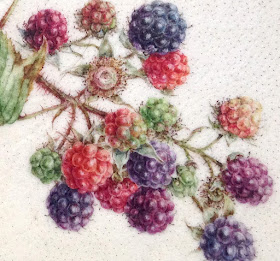 |
| A detail from the painting on natural vellum reveals the dark hair follicles, which are characteristic of a calf skin taken during the cold winter months. The finish is also softer on this vellum when compared to Kelmscott vellum. |
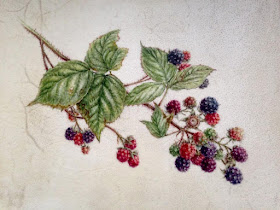 |
| Almost finished! you can see the colour and venation in the skin as well as the variation across the skin. I tried to use the veins sympathetically with the composition and could probably have added more, however the clock was ticking and the work was posted on the morning I left for Indonesia! Apologies for the slightly poor photo I didn't have time so took this on an iPhone. |
This piece of vellum is cut from a winter calf skin,
it presented a few new challenges, most of which I haven't encountered before. The surface of natural
vellum has dark hair follicles
and stronger venation also it accepts paint differently across
the surface. In some area it seemed to absorb the paint and in others it
repelled it due to the oils. The latter problem is resolved by a light
rubbing with pumice, which I tie in a bag made from old ladies tights!
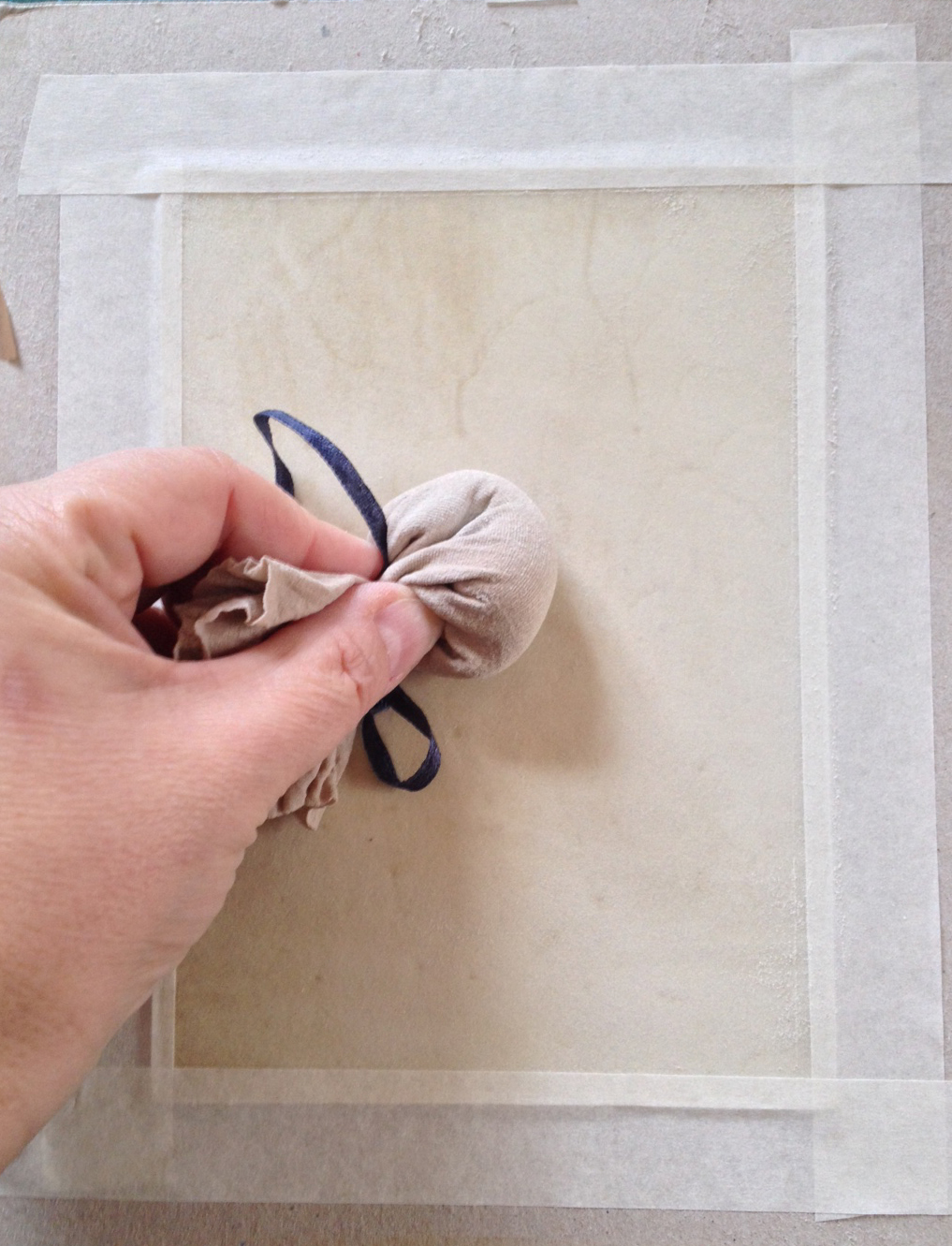 |
| Preparing a piece of vellum with fine grade pumice and French chalk fine |
It's also more difficult to achieve shiny highlights on natural vellum but I wanted to avoid the use of any titanium white or gouache, which I think
would spoil it in this particular case. The addition of opaque white paint, traditionally known as body colour can work on some subjects but it should not, in my opinion, ever be used as a substitute substitute for poor maintenance of highlights on fruit or leaves but can work for bloom, flower detail and hairs.
In addition to the natural vellum painting I had previously made a smaller study on
Kelmscott vellum which is easier to work on, it's also easier to achieve that desired shine but nevertheless I quite
liked the softer finish on natural vellum......a different look but still appealing.
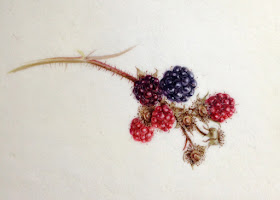 |
| A small study of the fruits on Kelmscott vellum, a much easier surface to paint on because it has a chalk wash which accepts the paint more readily |
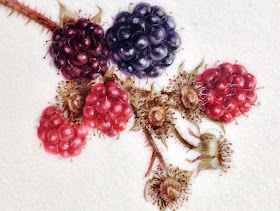 |
| A detail from the Kelmscott study shows that it's easier to achieve sharper edges and shine when compared to natural vellum, which gives a softer slightly 'diffused; finish. |
There's another story behind the Blackberries on natural vellum! It had previously been completely ruined by me, or so I though, when experimenting with mounting vellum on different surfaces this piece had gone very wrong and looked like this! It was bent and crumpled but I was determined to rescue it. Read about how to mount it
here in a previous post
 |
| A disaster had happened when I tried an early experiment mounting the vellum, it buckled and resisted the glue so I had to remove it leaving this mess. I rescued it by soaking it for about 10 minutes before remounting using a method that I now know works, I used Ampersand conservation board and rabbit skin glues. It was completely smooth after mounting onto board but the board did bend ever so slightly. |
I don't consider myself to be a fruit painter but blackberries are a bit of an old favourite, one of my very first paintings was a blackberry and bindweed, which my mum still has. Both grow in the lane where I live and I love the intertwining nature.
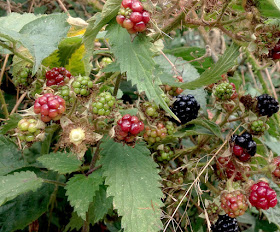 |
| Blackberries of varying stages of ripeness fill the lane near my home, mid August and there are still a few fruit in mid November. The colours are a gift to the botanical artist. |
This year I've also painted another study of blackberries, this one in my sketchbook alongside bindweed...... I never tire of blackberries!
On the subject of fruit, I heard this week that another fruit project completed earlier this year has finally made it into the shops. This was a series of illustrations for Method + Standard fruit vodka; strawberries, raspberries, apples and baby cornstalk were illustrated for this project, it was another tight deadline of around two months for all drafts and completed artwork. I've worked on a lot of labelling illustrations over the years, and this was a really lovely project to work on but very different from a typical botanical painting. The spacing and text layout positions place significant restrictions on the composition. The images have to work around the text and wrap around the bottle so only just peeping on to the front. This is tricky given the shapes, and, they also have to work as paintings and be used in other contexts for marketing, so two or three drafts are usually required to get it just right. Here's an composite image from the company posted on Instagram however due to copyright restrictions I can't post images of the product but the full the outcome can be seen at
Method + Standard Fruit Vodka
I'm very happy with the outcome and worked with a lovely design company on this project, you can see more of the packaging here
in this article
I've now caught up with the old blog posts so will post a blog on the sketchbook travels to Australia and Indonesia next week.










Great work as always Dianne - fascinated to read about the mounting of Vellum. So when you soaked it, dis you soak it in water (warm or cold?) and for how long? Do you then mount it while it is wet?
ReplyDeleteReally love the work you did for the Vodka bottles - it's so different to your normal work, which is testament to how good an artist you are because you work hard to satisfy your clients needs. Fabulous Dianne, really fabulous.
Thanks Jess, I soaked it in warm (not hot) water, say 5 minutes or just long enough to take the ripples out and wash of the glue off from the previous disaster. Then dried it off so it wasn't dripping wet, more damp. I made up the rabbit skin glue in advance so that it was cooling and pasted the back of the skin before laying it onto the ampersand I think it's the aquaboard ( conservation quality ) I wrapped the vellum very tight around the edges. The board has a very slight key on the surface which helps - you cant detect it through the vellum once it's mounted. Ideally you need about an inch spare all round for this. I let it dry off and put tracing paper over the surface and pressed it under many botanical books.....for good luck! and left it for about a week. To my surprise it was perfect but a very slight curve which is minor.... I think from being slightly too damp causing shrinkage. To be honest Jess I had no idea what I was doing but figured it was ruined anyway, it's all that old science training....I just had to try:) Anyhow I've mounted quite a few pieces now and it works a treat if I'm not too ambitious with the size. Just a light rub with pumice and chalk and its ready to go. I enjoyed the Vodka project, it was fun! not too many drafts fortunately. I do quite a few product illustrations. I think 10 new products this year.....some are very troublesome with plants that are a different shapes than the space they need to fit into! but this was a pleasure
DeleteThis comment has been removed by the author.
ReplyDeleteVery interesting post, thank you! Your blackberries look wonderful. And I admire your sketchbook! :)
ReplyDelete